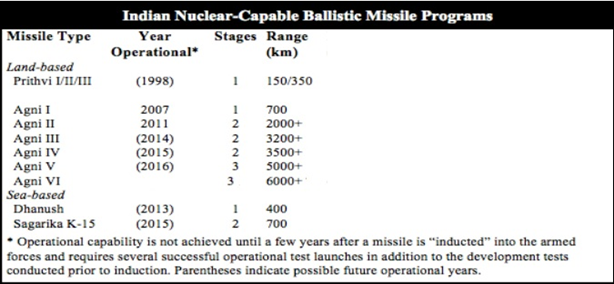In News:
- India recently carried out a successful launch of Agni-3 Intermediate Range Ballistic Missile from A.P.J. Abdul Kalam Island in Odisha.
- It was launched as part of routine user training launches carried out under the aegis of the Strategic Forces Command.
- India has also completed its nuclear triad and operationalised its second-strike capability, with nuclear ballistic missile submarine INS Arihant undertaking deterrence patrols.
- A nuclear triad is a three-pronged military structure that consists of land-launched nuclear missiles, nuclear-submarines and aircraft with nuclear missiles.
- A second-strike capability assures an ability to respond to a nuclear attack with powerful nuclear retaliation.
What’s in today’s article:
- About the Integrated Guided Missile Development Programme (IGMDP)
- About the Agni Missiles
- About the Strategic Forces Command (SFC)
The Integrated Guided Missile Development Programme (IGMDP): What’s in today’s article:
- About IGMDP:
- It was a programme for the R&D of the comprehensive range of missiles in India, started in 1982–83 under the leadership of Dr. APJ Abdul Kalam.
- It was a Ministry of Defence programme managed by the Defence Research and Development Organisation (DRDO) and Ordnance Factories Board.
- As part of this program, the Interim Test Range (renamed as A.P.J. Abdul Kalam Island in 2016) at Balasore in Odisha was also developed for missile testing.
- Types of missiles under the programme: APJ Abdul Kalam started multiple projects simultaneously to develop the following types of Indian Guided Missiles -
- Short Range Surface to Surface Missile (SSM) ‘Prithvi’
- Long Range Surface to Surface Missile (SSM) ‘Agni’
- Medium Range Surface to Air Missile (SAM) ‘Akash’
- Short Range Surface to Air Missile (SAM) ‘Trishul’
- Anti-tank Guided Missile (ATGM) ‘Nag’
About the Agni Missiles:

- It was initially conceived in the IGMDP as a technology demonstrator project in the form of a re-entry vehicle, and was later upgraded to a ballistic missile with different ranges.
- A ballistic missile is a type of missile that uses projectile motion to deliver warheads on a target.
- These weapons are guided only during relatively brief periods and most of the flight is unpowered.
- The Agni missile is a family of medium to intercontinental range ballistic missiles, named after one of the five elements of nature.
- Agni missiles are long range, nuclear weapons capable, surface to surface ballistic missiles.
- The first missile of the series, Agni-I was developed under the lGMDP and tested in 1989.
- After its success, the Agni missile program was separated from the IGMDP upon realizing its strategic importance.
- The Agni series of missiles constitute the backbone of India’s nuclear weapons delivery which also includes the Prithvi short range ballistic missiles and fighter aircraft.
About the Strategic Forces Command (SFC):
- Sometimes called Strategic Nuclear Command, SFC (created in 2003) forms part of India's Nuclear Command Authority (NCA).
- The NCA is the authority responsible for command, control and operational decisions regarding India's nuclear weapons programme.
- It comprises a Political Council headed by the Prime Minister of India and an Executive Council headed by the National Security Advisor.
- SFC is responsible for the management and administration of the country's tactical and strategic nuclear weapons stockpile.









